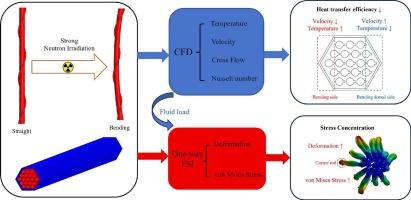Analysis of the effect of LFR bending fuel assembly on thermal–hydraulic characteristics
IF 2.3
3区 工程技术
Q1 NUCLEAR SCIENCE & TECHNOLOGY
引用次数: 0
Abstract
To investigate the effect of fuel rod bending on coolant flow and heat transfer in lead-cooled fast reactors, the CFD models of C-shaped bending fuel assembly are established in this paper. Results show that fuel rod bending reduces heat transfer efficiency by 2.1 %, 5.4 %, and 7.4 % under Cases 1–3, respectively. Compared with the normal condition, the coolant velocity in corner and edge subchannels on the bending side decreases, with the maximum temperature rises reaching 11.12 K and 13.5 K under Case 3, respectively. On the bending dorsal side, the coolant velocity in both corner and edge subchannels exceeds the LFR design limit of 2 m/s under Cases 2 and 3. Bending also amplifies the deformation of fuel rods under fluid load, causing stress concentration on the 15th corner rod, the maximum deformation rises by 0.069 mm and the von Mises stress by 2.04 MPa under Case 3.

LFR弯曲燃料组件对热工特性的影响分析
为了研究燃料棒弯曲对铅冷快堆中冷却剂流动和传热的影响,建立了c型弯曲燃料组件的CFD模型。结果表明,在工况1-3下,燃料棒弯曲分别使换热效率降低2.1%、5.4%和7.4%。与正常工况相比,弯曲侧弯角子通道和边缘子通道的冷却剂速度减小,在情况3下的最高温升分别达到11.12 K和13.5 K。在弯曲背侧,在工况2和工况3下,拐角和边缘子通道的冷却剂速度均超过LFR设计极限2m /s。弯曲也放大了燃料棒在流体载荷下的变形,在工况3下,第15角棒的最大变形增大0.069 mm, von Mises应力增大2.04 MPa。
本文章由计算机程序翻译,如有差异,请以英文原文为准。
求助全文
约1分钟内获得全文
求助全文
来源期刊

Annals of Nuclear Energy
工程技术-核科学技术
CiteScore
4.30
自引率
21.10%
发文量
632
审稿时长
7.3 months
期刊介绍:
Annals of Nuclear Energy provides an international medium for the communication of original research, ideas and developments in all areas of the field of nuclear energy science and technology. Its scope embraces nuclear fuel reserves, fuel cycles and cost, materials, processing, system and component technology (fission only), design and optimization, direct conversion of nuclear energy sources, environmental control, reactor physics, heat transfer and fluid dynamics, structural analysis, fuel management, future developments, nuclear fuel and safety, nuclear aerosol, neutron physics, computer technology (both software and hardware), risk assessment, radioactive waste disposal and reactor thermal hydraulics. Papers submitted to Annals need to demonstrate a clear link to nuclear power generation/nuclear engineering. Papers which deal with pure nuclear physics, pure health physics, imaging, or attenuation and shielding properties of concretes and various geological materials are not within the scope of the journal. Also, papers that deal with policy or economics are not within the scope of the journal.
 求助内容:
求助内容: 应助结果提醒方式:
应助结果提醒方式:


